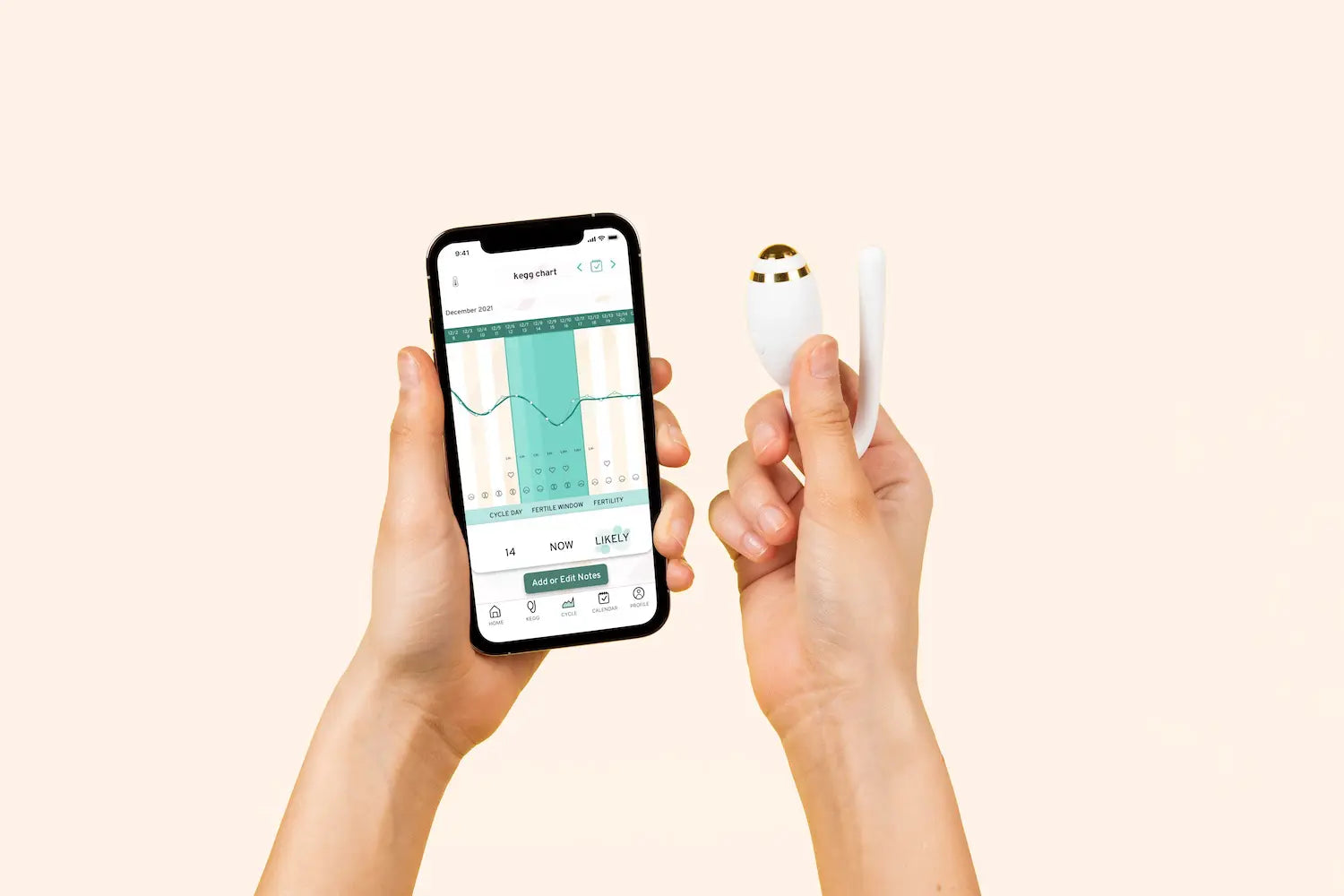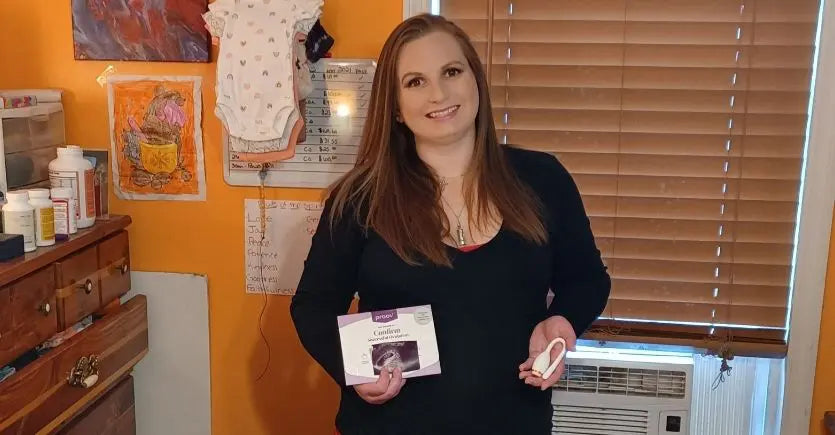At a glance:
- PCOS is the number one cause of infertility in women and kegg has helped hundreds of women with PCOS on their trying to conceive journeys
- Kegg detects the changes in cervical fluid allowing the user to see when their full fertile window, allowing the optimal timing when trying to conceive
- PCOS impacts women differently (see chart variations below), ranging from anovulatory cycles to those with multiple fertile valleys.
- With kegg, the user can ensure they do not miss an opportunity to try to conceive
PCOS is a leading cause of infertility, impacting about 5 million women in their reproductive years. Many women with PCOS share that tracking their fertility is especially challenging. While kegg has not been clinically tested on women with PCOS, there is a growing number of women with PCOS who turn to kegg to successfully track their fertility.
What insights does kegg show?
kegg detects the changes in the cervical fluid. More specifically, kegg detects the electrolyte changes in the cervical fluid which shift with the hormonal changes of the cycle.
- The fertile time of the cycle appears as a valley.
- As estrogen rises and the body prepares to ovulate, the cervical fluid becomes hospitable to sperm. The kegg data trends downwards.
- As the fertile window closes, the rising progesterone causes a shift in the electrolytes resulting in a rise in kegg data.

What insights does a user with PCOS gain with kegg?
PCOS impacts women differently. While some women ovulate fairly consistently with regular periods, others may not ovulate without medical intervention. For this reason, there is not one pattern of kegg trends consistent among all women with PCOS.
In order for kegg to provide insights regarding the fertile window, the user must ovulate and have periods. Kegg provides fertile window predictions for cycles that are 21-40 days in length. However, given that many women with PCOS have cycle irregularities and/or cycles outside of this range, most have reported they track their fertility primarily by watching the kegg trend line.
Since the electrolytes in the cervical fluid fluctuate according to the hormonal changes of the cycle, the kegg user can look for descending values on their kegg readings to predict when they are entering their fertile window. The kegg user can presume their fertile window is ending when they see a rise in kegg data, as the rise in progesterone results in a change in the electrolytes of the cervical fluid.
In order for kegg to provide insights regarding the fertile window, the user must ovulate and have periods. Kegg provides fertile window predictions for cycles that are 21-40 days in length. However, given that many women with PCOS have cycle irregularities and/or cycles outside of this range, most have reported they track their fertility primarily by watching the kegg trend line.
Since the electrolytes in the cervical fluid fluctuate according to the hormonal changes of the cycle, the kegg user can look for descending values on their kegg readings to predict when they are entering their fertile window. The kegg user can presume their fertile window is ending when they see a rise in kegg data, as the rise in progesterone results in a change in the electrolytes of the cervical fluid.
Chart variation
The insights kegg provides depend on the unique characteristics of the kegg user.
PCOS 1: Multiple ‘valleys’
Some women with PCOS have observed what appears to be multiple fertile valleys in their kegg data. In this example the user purposefully timed her trying to conceive efforts during the dips or valleys assuming these could be fertile valleys and attempts at ovulation. A few days after her first valley and rise she found her trend line dropping again and decided to have sex on those days too just in case her first valley wasn’t successful in achieving ovulation. This was followed by an 11-day luteal phase. Her typical luteal phase is 11-12 days. If the first valley had been successful, her period would have come much sooner near cycle day 29, therefore this confirms the first attempt at ovulation was not successful.

PCOS 2a: Unreliable LH results
A classic feature of PCOS is multiple or sustained LH surges. This user noted in her chart when she had an LH surge. Note the two “dips” or valleys and the two positive LH test results, on CD 16-17 and CD 31.

PCOS 2b: sustained LH surge
Another common occurrence for women with PCOS is many days in a row with positive LH results. Without serum hormone testing and ultrasounds throughout the cycle, we cannot confirm when or even IF ovulation took place. In the chart below, you will notice this user had several days of a positive LH result. Her kegg results helped guide her, as she noted her readings continuing to descend, followed by a rise. She then had a typical 12-day luteal phase.

PCOS 3: Erratic readings
Yet another finding for PCOS users is somewhat erratic day-to-day readings. This can be true for users who do not have PCOS too and can often be helped by being more consistent with the measurement time. As you will see there is no obvious fertile window valley.

PCOS 4: flat trend line
A final pattern we have seen in some users with PCOS is very low and flat kegg data. Some users that have experienced “flat” kegg reading will have some very flat cycles and other cycles with more typical patterns. This cycle was likely anovulatory but not confirmed with progesterone testing or ultrasound.

We have heard from happy mamas who were able to successfully conceive using kegg despite their irregular cycles due to PCOS. Check out charts of kegg users who successfully conceived despite having irregular cycles.

Above is a kegg chart in which the mama with PCOS conceived. She was able to spot the “valley” in her daily readings to predict that she was in her fertile window.

This mama with PCOS conceived during her first kegg cycle. She shared “I am 34 with PCOS and I was using Kegg to conceive my second child naturally. My first child was conceived after 3 years of trying, on our second try with fertility medication and I was hoping to avoid that this time. I know our main issue was timing and with OPK’s I would get false positives so I searched for a different way and I came across Kegg. I often had a hard time reading my own cervical mucus so I thought this would be great. I ordered it shortly before I found out that I did not get pregnant on our first cycle trying. I started using it on my second cycle. After going into a descent around cycle day 14, I did a Proov PDG test 7 days later to confirm and I did not ovulate yet. I kept doing my daily readings until I went into another descent around cycle day 25. My basal body temperature, my opk tests and my Kegg readings all lined up and pointed to ovulation happening. A week later, I took a Proov test and confirmed, finally, I ovulated! With the help of Kegg I was able to determine even on my first cycle when I was my fertile window. Without Kegg, it would have basically been a shot in the dark. I would have never known I ovulated so late. Shortly after we tried that cycle, I had a doctor’s appointment where they told me I would most likely need the help of a Reproductive Endocrinologist to conceive again. However, to my utter shock, I took a test a few days later and I was pregnant! I truly feel like Kegg is a wonderful device and without it, maybe I would’ve needed a Reproductive Endocrinologist but we did use it and we conceived naturally and I am so over the moon and so grateful for this product! I just had my 7-week sonogram and saw the heartbeat. Thank you kegg, I can’t thank you enough! We are so overjoyed.”
Trying to conceive with PCOS can be a challenging journey. With the added insights of kegg*, many women with PCOS have been able to successfully track their fertility, gain a better understanding of how PCOS impacts their cycles, and go on to successfully conceive.
*Please note: while many women with PCOS choose to use kegg, kegg has not been clinically tested in women with PCOS. kegg cannot be used to diagnose or treat any medical condition.
Trying to conceive with PCOS can be a challenging journey. With the added insights of kegg*, many women with PCOS have been able to successfully track their fertility, gain a better understanding of how PCOS impacts their cycles, and go on to successfully conceive.
*Please note: while many women with PCOS choose to use kegg, kegg has not been clinically tested in women with PCOS. kegg cannot be used to diagnose or treat any medical condition.



